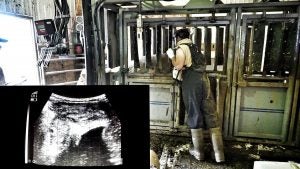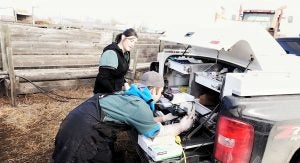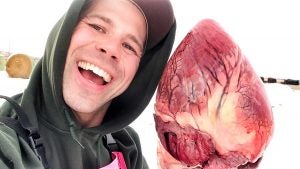Chaos. The excitement of not knowing exactly what the day holds. Never doing the same thing twice. This is what Cody Creelman, Cow Vet, loves most about his job. Veterinary medicine as a whole provides this chaos for many of its practitioners. However, Creelman’s experience is unique because he works as a veterinarian in one of the few beef-cattle only practices in Canada. He also highlights his day on Instagram, on Snapchat at username creelmancody, and on a vlog on YouTube.

In his job, this cow vet has seen some crazy things; he shares some of his favorite cases with us:
1. The case with the Botox heifer
I was called out to check on a heifer that had large salivary swelling off the jaw. It can happen for a few different reasons, the most common being that there is a blocked salivary duct. This large saliva filled cyst can rupture and then you get a fistula, an infected tract. It had ruptured, so I was looking at this beautiful, purebred black Angus heifer with this nasty, dripping salivary fistula. The owner was willing to try to save her because of her genetic value. However, the procedures that surgeons told me about had low success rate and high complication rate. So, I was unsatisfied with the normal solutions. I remembered back in fourth-year vet school that the small-animal folks would inject human Botox into the salivary glands of dogs that slobber a lot. I did a literature review to see if anyone had tried it to heal up a salivary fistula. I convinced the farmer to give it a shot. I headed out to the postmortem pit and dissected salivary glands until I knew exactly where they were in cows. I ultra-sounded the salivary gland and did 14 injections of Botox into this heifer. Within 48 hours, the heifer was not dripping anymore. Within two weeks, she was perfectly healed. It has never happened again, and she is living as a mature beef cow in Saskatewan. That is the only case of Botox being used in a cow that I know of. We did learn that the withdrawal time for Botox in a cow is 21 days.
2. The inside-out calf
Schistosomus reflexus is a congenital disorder where calves are born with a reflexed spine and all their intestines are outside their body. Often, they go right to term with a beating heart. Farmers will notice either intestines coming out of the cow’s vulva and think she is prolapsing or all of the feet come out first. Usually a C-section needs to be done for the cow to successfully calve. The prevalence of this according to literature is 1 in 100,000 calves. I have had three of them in my career so far, and I am pretty sure I haven’t calved out 300,000 cows. Obviously, that calf does not survive, and the cow is normally culled. There is not a lot we as veterinarians can do to prevent it, it is a learning experience.
3. The YouTube self-taught surgery
I had a group of students with me, and we were called out to a farm with a newborn calf that was not suckling. The calf had a bilateral nasal cleft, just like a cleft palate in humans. I had never seen one before and certainly never done a surgery to fix it. There was not a lot of information about the surgery in cows, but there was plenty for humans. I found many YouTube videos where they actually showed the surgery being performed. I watched those videos until I felt confident enough to go out there and perform the surgery. Everything went off without a hitch and the calf was suckling later on. The unique thing about this, besides the fact that I taught myself the surgery using YouTube was the owner’s anonymity. They ran a purebred operation and the client did not want people judging them because of the genetic anomaly. The video ended up going viral and the owners read every single comment. They later said they wished they had been more open about it, because the response was overwhelmingly positive. Most comments talked about how it was so amazing that a farmer would dedicate so much time and resources to give the calf a chance.

4. The cow with horse hooves
I was called out to see a calf that was four days old and had not stood yet. The students with me did a full physical exam and gave me heart rate, temperature, respiration and then told me about the contracted tendons that the farmer had mentioned. I told them to take a closer look and count the hooves. They noticed he was mule footed on three out of the four legs. Meaning he only had one claw, just like a foal would. That is syndactyly or one foot. It is a genetic disease that happens in most commonly in Holstein animals. But this calf had contracted tendons and perfectly formed foal’s hooves. There is a poor prognosis, so we ended up euthanizing because there was almost no chance he was going to be a normal calf or live a normal life.
5. The double-cervixed heifer
I got called out to a vaginal prolapse in a Hereford heifer. When I looked at the prolapse, instead of the normal anatomy looking me in the face, where the cervix is central, there were two perfectly formed cervixes sitting there. She was a two-cervixed or double-cervixed heifer. I replaced the prolapse and told the owners to watch the heifer closely because I was not sure if one cervix was open all the way, both cervixes were open, or there was a “blind end” where one cervix does not open to the uterus. I thought it was a possibility that she would dilate both of her cervixes, and we do not know what would happen after that. They called me when she started to calve because sure enough she was having issues. Both cervixes had dilated and the calf had gone through one and the leg went through the other. There was no possible way to manipulate the calf back through just one cervix. I ended up doing surgery and cut the cervixes together to make one, which I had never heard of or seen done. We then elected to do a C-section because of the swelling. The calf was unfortunately dead. The double-cervixed heifer will always haunt me.
Creelman strives to highlight the good, bad, and sometimes ugly of veterinary medicine on his vlog. He loves to showcase the abnormal normal he has every single day while advocating for veterinary medicine and inspiring future veterinarians. His advice, “Always have a goal. Try as hard as you can to find that passion, have that purpose. For me if I don’t have that thing I’m striving for, if I don’t have that fire in my belly, then I’m not feeling like myself.”
Go find your passion, and follow along with Cody’s passion on his vlog and social media channels!




